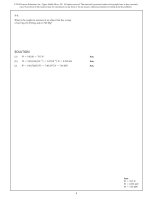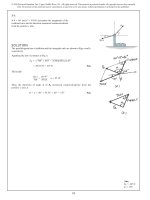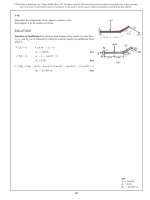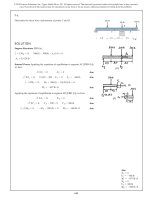Dynamics 14th edition by r c hibbeler dynamics 14th edition by r c hibbeler
Bạn đang xem bản rút gọn của tài liệu. Xem và tải ngay bản đầy đủ của tài liệu tại đây (377.41 KB, 18 trang )
RELATIVE-MOTION ANALYSIS OF TWO PARTICLES
USING TRANSLATING AXES
Today’s Objectives:
Students will be able to:
1. Understand translating
frames of reference.
2. Use translating frames of
reference to analyze relative
motion.
Dynamics, Fourteenth Edition
R.C. Hibbeler
In-Class Activities:
• Check Homework,
• Reading Quiz
• Applications
• Relative Position, Velocity
and Acceleration
• Vector & Graphical Methods
• Concept Quiz
• Group Problem Solving
• Attention Quiz
Copyright ©2016 by Pearson Education, Inc.
All rights reserved.
READING QUIZ
1. The velocity of B relative to A is defined as
A) vB – vA .
B) vA – vB .
C) vB + vA .
D) vA + vB .
2. Since two-dimensional vector addition forms a triangle,
there can be at most _________ unknowns (either
magnitudes and/or directions of the vectors).
A) one
B) two
C) three
D) four
Dynamics, Fourteenth Edition
R.C. Hibbeler
Copyright ©2016 by Pearson Education, Inc.
All rights reserved.
APPLICATIONS
When you try to hit a
moving object, the position,
velocity, and acceleration of
the object all have to be
accounted for by your mind.
You are smarter than you
thought!
Here, the boy on the ground is at d = 10 ft when the girl in
the window throws the ball to him.
If the boy on the ground is running at a constant speed of 4
ft/s, how fast should the ball be thrown?
Dynamics, Fourteenth Edition
R.C. Hibbeler
Copyright ©2016 by Pearson Education, Inc.
All rights reserved.
APPLICATIONS (continued)
When fighter jets take off or
land on an aircraft carrier,
the velocity of the carrier
becomes an issue.
If the aircraft carrier is underway with a forward velocity of 50
km/hr and plane A takes off at a horizontal air speed of 200
km/hr (measured by someone on the water), how do we find
the velocity of the plane relative to the carrier?
How would you find the same thing for airplane B?
How does the wind impact this sort of situation?
Dynamics, Fourteenth Edition
R.C. Hibbeler
Copyright ©2016 by Pearson Education, Inc.
All rights reserved.
RELATIVE POSITION (Section 12.10)
The absolute positions of two
particles A and B with respect to
the fixed x, y, z-reference frame are
given by rA and rB. The position of
B relative to A is represented by
rB/A = rB – rA
Therefore, if rB = (10 i + 2 j ) m
and
rA = (4 i + 5 j ) m,
then
rB/A = rB – rA = (6 i – 3 j ) m.
Dynamics, Fourteenth Edition
R.C. Hibbeler
Copyright ©2016 by Pearson Education, Inc.
All rights reserved.
RELATIVE VELOCITY
To determine the relative velocity of B
with respect to A, the time derivative
of the relative position equation is
taken.
vB/A = vB – vA
or
vB = vA + vB/A
In these equations, vB and vA are called absolute velocities
and vB/A is the relative velocity of B with respect to A.
Note that vB/A = - vA/B .
Dynamics, Fourteenth Edition
R.C. Hibbeler
Copyright ©2016 by Pearson Education, Inc.
All rights reserved.
RELATIVE ACCELERATION
The time derivative of the relative
velocity equation yields a similar
vector relationship between the
absolute and relative accelerations
of particles A and B.
These derivatives yield: aB/A = aB – aA
or
aB = aA + aB/A
Dynamics, Fourteenth Edition
R.C. Hibbeler
Copyright ©2016 by Pearson Education, Inc.
All rights reserved.
SOLVING PROBLEMS
Since the relative motion equations are vector equations,
problems involving them may be solved in one of two ways.
For instance, the velocity vectors in vB = vA + vB/A could be
written as two dimensional (2-D) Cartesian vectors and the
resulting 2-D scalar component equations solved for up to
two unknowns.
Alternatively, vector problems can be solved “graphically” by
use of trigonometry. This approach usually makes use of the
law of sines or the law of cosines.
Could a CAD system be used to solve these types of problems?
Dynamics, Fourteenth Edition
R.C. Hibbeler
Copyright ©2016 by Pearson Education, Inc.
All rights reserved.
LAWS OF SINES AND COSINES
Since vector addition or subtraction
forms a triangle, sine and cosine laws can
b
a
be applied to solve for relative or
absolute velocities and accelerations. As
A
a review, their formulations are provided
B
c
below.
b
a
c
Law of Sines:
sin A
sin B
sin C
C
Law of Cosines:
a 2 b 2 c 2 2 bc cos A
2
2
2
b a c 2 ac cos B
2
2
2
a
c
b 2 ab cos C
Dynamics, Fourteenth Edition
R.C. Hibbeler
Copyright ©2016 by Pearson Education, Inc.
All rights reserved.
EXAMPLE
Given:
Find:
Two aircraft as shown.
vA = 650 km/h
vB = 800 km/h
vB/A
Plan:vectors vA and vB in
1) Vector Method: Write
Cartesian form, then determine vB – vA
2) Graphical Method: Draw vectors vA and vB from a
common point. Apply the laws of sines and cosines to
determine vB/A.
Dynamics, Fourteenth Edition
R.C. Hibbeler
Copyright ©2016 by Pearson Education, Inc.
All rights reserved.
EXAMPLE (continued)
Solution:
1) Vector Method
vA = (650 i ) km/h
vB = –800 cos 60 i – 800 sin 60 j
= ( –400 i – 692.8 j) km/h
vB/A = vB – vA = (–1050 i – 692.8 j) km/h
vB /A km/h
= tan-1(
) = 33.4
Dynamics, Fourteenth Edition
R.C. Hibbeler
Copyright ©2016 by Pearson Education, Inc.
All rights reserved.
EXAMPLE (continued)
2) Graphical Method:
Note that the vector that measures the tip of B relative to A is vB/A.
650 km/h
vA
800 km/h 120
vB
vB/A
Law of Cosines:
(vB/A)2 = (800) 2 + (650) 2 − (800) (650) cos 120
vB/A = 1258 km/h
Law of Sines:
vB/A
sin(120 )
Dynamics, Fourteenth Edition
R.C. Hibbeler
=
vA
sin
or
Copyright ©2016 by Pearson Education, Inc.
All rights reserved.
CONCEPT QUIZ
1. Two particles, A and B, are moving in
the directions shown. What should be
the angle so that vB/A is minimum?
A) 0°
B) 180°
C) 90°
D) 270°
vB = 4 ft/s
B
vA= 3 ft/s
A
2. Determine the velocity of plane A with respect to plane B.
A) (400 i + 520 j ) km/hr
B) (1220 i - 300 j ) km/hr
C) (-181 i - 300 j ) km/hr
30
D) (-1220 i + 300 j ) km/hr
Dynamics, Fourteenth Edition
R.C. Hibbeler
Copyright ©2016 by Pearson Education, Inc.
All rights reserved.
GROUP PROBLEM SOLVING
Given: Car A moves in a straight line
while Car B moves along a
curve having a radius of
curvature of 200 m.
vA = 40 m/s
vB = 30 m/s
aA = 4 m/s2
aB = -3 m/s2
Find: vB/A
aB/A
Plan: Write the velocity and acceleration vectors for
Cars A and B. Determine vB/A and aB/A by using
vector relationships.
Dynamics, Fourteenth Edition
R.C. Hibbeler
Copyright ©2016 by Pearson Education, Inc.
All rights reserved.
GROUP PROBLEM SOLVING (continued)
y
Solution:
The velocity of B is:
vB = -30 sin(30) i + 30 cos(30) j
= (-15 i + 25.98 j) m/s
The velocity of A is:
vA = 40 j (m/s)
x
The relative velocity of B with respect to A is (vB/A):
vB/A = vB – vA = (-15 i + 25.98 j) – (40 j) = (-15 i – 14.02 j) m/s
or
vB/A =
(-15)2 + (-14.02)2 = 20.5 m/s
14.02
= tan-1( 15
) = 43.1°
Dynamics, Fourteenth Edition
R.C. Hibbeler
Copyright ©2016 by Pearson Education, Inc.
All rights reserved.
GROUP PROBLEM SOLVING (continued)
g a curve, the acceleration of B is:
B = (at)B + (an)B = [-(-3) sin(30) i + (-3) cos(30) j]
302
+ [- (
) cos(30) i - (
) sin(30) j ]
200
B
302
200
y
= ( -2.397 i – 4.848 j ) m/s2
The acceleration of A is: aA = (4 j ) m/s2
x
The relative acceleration of B with respect to A is:
aB/A = aB – aA = ( -2.397 i – 8.848 j ) m/s2
aB/A =
(-2.397)2 + (-8.848)2 = 9.17 m/s2
= tan-1(8.848 / 2.397) = 74.8°
Dynamics, Fourteenth Edition
R.C. Hibbeler
Copyright ©2016 by Pearson Education, Inc.
All rights reserved.
ATTENTION QUIZ
1. Determine the relative velocity of particle B with respect to
particle A.
y
A) (48i + 30j) km/h
B
v =100 km/h
B) (- 48i + 30j ) km/h
C) (48i - 30j ) km/h
30
x
A
v =60 km/h
D) (- 48i - 30j ) km/h
B
A
2. If theta equals 90° and A and B start moving from the same
point, what is the magnitude of rB/A at t = 5 s?
A)
B)
C)
D)
20 ft
15 ft
18 ft
25 ft
Dynamics, Fourteenth Edition
R.C. Hibbeler
B
A
vB 4 ft/s
vA 3 ft/s
Copyright ©2016 by Pearson Education, Inc.
All rights reserved.
End of the Lecture
Let Learning Continue
Dynamics, Fourteenth Edition
R.C. Hibbeler
Copyright ©2016 by Pearson Education, Inc.
All rights reserved.









